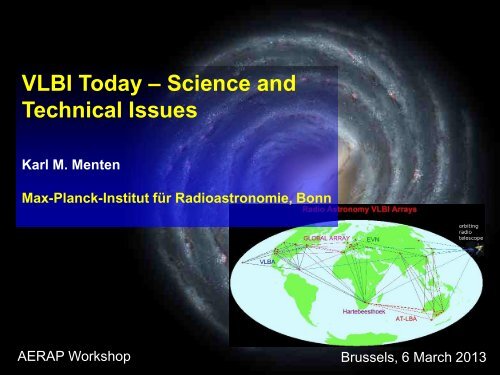Presentation by Karl Menten - aerap
Presentation by Karl Menten - aerap
Presentation by Karl Menten - aerap
Create successful ePaper yourself
Turn your PDF publications into a flip-book with our unique Google optimized e-Paper software.
VLBI Today – Science andTechnical Issues<strong>Karl</strong> M. <strong>Menten</strong>Max-Planck-Institut für Radioastronomie, BonnAERAP Workshop Brussels, 6 March 2013
VLBI Sources must have non-thermalradio emission• Active Galactic Nuclei• Radio “active” stars• Cosmic masersMicrowaveAmplification <strong>by</strong>StimulatedEmission ofRadiationWehrle et al. 1998
VLBI from the mid1960s on: ActiveGalactic Nucleiand their jets3C279v ~ 3.5 cA. Wehrle
Massi et al. 2008
MERLINRedshift 0.88582 absorption in the HC 3 N J = 3-2 and 5-4lines toward the PKS 1830-211 gravitational lens systemSato, Reid, <strong>Menten</strong>, & Carilli 2013
Phase referencingTargetsourcea fewdegreesBackgroundquasarVLBA: Switch every 15second between maserand quasar. 50% duty cycle•• Allows imaging of weaksources• Provides excellentastrometric accuracy(down to 10 µarcsec)
VLBI Trigonometric Parallaxesradio sourcehttp://veraserver.mtk.nao.ac.jp/outline/vera2-e.html
Parallax Signatures
K-band image©M. McCaughrean
<strong>Menten</strong> et al. 2007
GLOSTAR: A Global View of Star Formation in the Milky WayEuropean Research Council Advanced Investigator GrantPlanck-Institut fürMax-
Mapping the Milky WaySun• Preliminary results for 62parallaxes from VERA, EVN &VLBA:blue (s d < 0.5 kpc)green (s d > 0.5 kpc)• Tracing outer spiral arms• Inner, bar-region is messySgr B2W49Artist conception: Robert Hurt (NASA:SSC)
Inner Perseus Arm (Zhang et al. 2013)
Masers with parallaxesCatalogued 6.7 GHz CH 3 OH Masers• near kinematic distance• far kinematic distance
Cape VerdeanIslandsMauritius
HIPPARCOS(HIgh Precision PARallax COllecting Satellite)118,000 stellar parallaxess p ~ 0.001 arcseconds (1 mas)10% accuracy at 100 pc…mapped solar neighborhoodNext great space missions:GAIA & SIM: ~10 mas(Perryman et al 1997 A&A 323 49)
European VLBI Network
East Asia VLBI Network
VERAhttp://veraserver.mtk.nao.ac.jp/outline/vera2-e.html
The Long Baseline Array (Australia)
Global VLBI Network
VLBA
The Very Long Baseline Array (VLBA)Angular resolution:q f ~l/D ~ 1 cm / 8000 km = 250 masCentroid Precision:0.5 q f / SNR ~ 10 masSystematics:path length errors ~ 2 cm (~2 l)• Radio waves “see” throughgalaxy• Can “synthesize” telescopethe size of the Earthshift position <strong>by</strong> ~ 2q f ~ 500 masRelative positions (to QSOs):DQ ~ 1 deg (0.02 rad)cancel systematics: DQ*2q f ~ 10 mas
VLBA
e-VLBI• connects VLBI radio telescopes in realtime,while still employing the local timereferences of the VLBI technique.• Gigabit per second links via• their National Research Networksand• the Pan-European researchnetwork GEANT2IRC+10420
Modern VLBI requires:• Broad receiver bandwidths. Gives:• Good continuum sensitivity• Frequency agility (e.g, for redshiftedspectral line)• Fast switching• A dedicated network, allowing repeatedobservations• Broad bandwidth connectivity• Appreciable collecting area• A really good science case!




